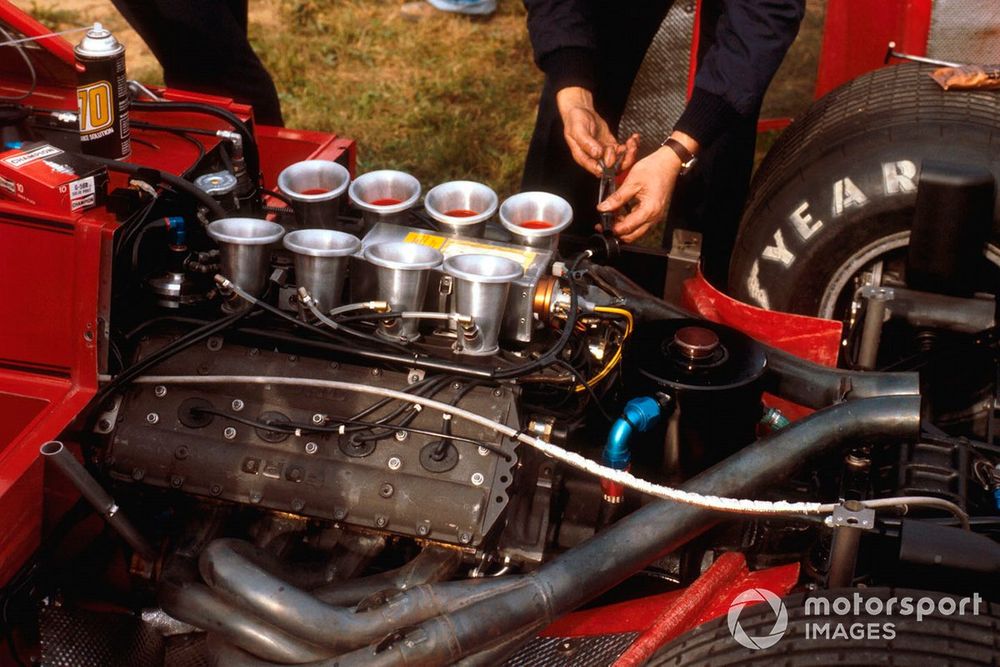It was on the morning of the glitzy season launch at London’s O2 Arena in February when Formula 1 lost its collective head. There, it’s said, during an F1 Commission meeting, Christian Horner – Red Bull’s then team principal – set his smartphone in the middle of the table.
“Bring back V10s” hissed the voice at the other end of the line: former F1 ‘ringmaster’ Bernie Ecclestone. And, lo, the herd began its charge in that direction, only to crash upon the indifference of F1’s engine manufacturers during a crunch meeting ahead of the Bahrain GP.
But FIA president Mohammed Ben Sulayem, one of those who got rather ahead of themselves on that chilly February day in London, still believes in the principle of a return to natural aspiration and set out his stall during a media briefing ahead of the British GP in July.
The new plan accommodates reservations expressed by the majority of the engine manufacturers during the Bahrain summit: that V10s were unsuitable on many levels, not least the road-relevance front; and some form of electrification would have to be included to provide synergies with road car technologies.
It’s a debate which has been raging between paddock insiders for many years: should F1 slavishly mirror road car trends or should it adopt a so-called ‘set controls for the heart of the sun’ policy, focusing completely on noise and power even if it alienates the manufacturers? Many purists espouse the latter but acknowledge the many practical problems, such as what would happen to the manufacturer-based teams and who would actually build the engines.
V8s, as now espoused by Ben Sulayem, are more acceptable to the manufacturers since many of them still have engines of that configuration somewhere in the range. At the same time the idea of internal combustion is undergoing something of a renaissance, owing to new technologies and developments in the global trading picture.
A Ford DFV V8 engine in the back of a Brabham BT49
Photo by: Motorsport Images
For a long time the direction of travel in the car industry has been towards full electrification, pushed by government legislation. But a significant proportion of consumers remain resistant, viewing electric cars as too expensive (and, of course, there are those who fear their genitals may fall off if they are seen driving anything other than a car with a loud, noisy and powerful internal combustion engine).
Faced with this and an influx of cheaper, state-subsidised vehicles exported from China, the western car industry is beginning to panic. Former Renault Group boss Luca de Meo admitted as much before he quit.
So there is still room for the internal combustion engine, provided the new generation of synthetic fuels can be produced at scale for a reasonable cost.
Assuming F1 did return to a V8 engine format, there would be details to work out regarding size and the proportion of electrification. Next year the split will be 50:50 but this has proved controversial, and the technical formula has had to be adapted to embrace adaptive aerodynamic devices to mitigate potential power shortfalls on the straights. It’s understood that the solution envisioned by the FIA is to move to an 80:20 ratio in favour of the ICU, or even 90:10.
The new format would be introduced when the 2026 technical package has run its course, most likely 2030, though the president has suggested it could be earlier.
“We need to do it soon,” he said at Silverstone. “You need three years, so hopefully by 2029 we have something there.”

2026 Formula 1 rules
Photo by: FIA
Ben Sulayem has also talked about achieving radical cost savings by standardising components including the gearbox and the hybrid system. Former president Max Mosley tried to drive through something along these lines at the end of 2008, during the global financial crisis, running a tender process for a homologated drivetrain (ultimately won by Cosworth and Hewland). An additional wrinkle of the plan was to open up new grid spots and have those teams using the standard powertrain effectively running in a championship tier of their own, with a budget cap.
But that idea was ultimately too complicated and lost impetus when Mosley stood down. Jean Todt, the next president, let it die entirely.
There is an argument to say gearboxes are expensive to design, develop and build, and are no longer performance differentiators, so having a standardised component isn’t necessarily a negative. There may be grumblings about whoever wins the putative tender but F1 has been here before, when McLaren Applied Technologies won the contract to supply the whole grid with homologated Engine Control Units. Fears of inequality and skulduggery proved unfounded.
Standardised hybrid components may be more difficult for the engine manufacturers to digest – but, equally, this is also an ‘invisible’ system so far as the audience is concerned and if it can be made less expensive, it will find support. The FIA’s position is that cost saving remains one of the most important factors even at a time when F1 is thriving commercially – because that situation could change at any time based on geopolitics and the global economy.
“As the FIA we are the moderators during the discussion of the regulations, mindful to contain costs and create a level playing field for all,” FIA single-seater director Nikolas Tombazis told Motorsport.com earlier this year.
“There is some strong resistance at times, as you would expect, from teams or PU manufacturers protecting their interests or investment. Cost-cutting and level of technological freedom are at loggerheads with each other. It is not easy to have both.
“The PU manufacturers came [to discussion regarding the 2026 regulations] with many proposals for cost-cutting on a number of items relating to the engine. They centred on simplification, eliminating certain materials, processes and technologies.
“The amount of cost-cutting we’ve achieved is not as much as we would all have liked. While we are in a very healthy position as a sport, financially and in terms of popularity, we should never be complacent about that: cost-cutting should always have a high priority.”

The Formula One Championship-winning Power Units: Mercedes-AMG F1 M09 EQ Power+ (2018), Mercedes-AMG F1 M08 EQ Power+ (2017), Mercedes-Benz PU106C Hybrid (2016), Mercedes-Benz PU106B Hybrid (2015), Mercedes-Benz PU106A Hybrid (2014)
Photo by: Mercedes AMG
“Many of the manufacturers produce V8s in their cars, so commercially it’s correct,” said Ben Sulayem at Silverstone. “How much is it? The target is more than 50 percent [cheaper] in everything.”
This could be achieved not just through standardising parts but also mandating cheaper materials. It’s known, for instance, that the FIA wanted to move to aluminium pistons but the engine manufacturers, having initially supported the idea, U-turned en masse.
Another issue F1 faces in its drive towards ‘net zero’ is the cost of the fully sustainable fuel which will be mandatory next year, said to be in the region of $275-$300 per litre. This reflects both the R&D investment which has had to go into developing these fuels and the energy-intensive means of production. As yet there is no solution to the problem of producing at scale and to a reasonable cost.
Since all the teams have commercial fuel-and-lubes supply deals, the question of who actually absorbs those costs is tricky to unpick – and likely to differ depending on how individual deals are structured. Which is why another of Ben Sulayem’s proposals is likely to face resistance: a single fuel supplier.
What goes in the tank is less of a performance differentiator than it used to be – a chemical composition close to pump fuel is now prescribed, as is a sustainable element – but fuel brands still rely on performance for their storytelling. Shell, for instance, has built the identity of its VPower blend around its partnership with Ferrari.
Would the story survive if the Ferrari were to become a mere mobile billboard for the likes of Shell, while the go-juice sloshing around inside had a rather different provenance? Perhaps – after all, we live in an age of profound superficiality.
Ultimately if costs can be reduced as much as the president would like, the grid as a whole will benefit – and few will care whether you have a tiger in your tank or not.
In this article
Be the first to know and subscribe for real-time news email updates on these topics
Subscribe to news alerts








